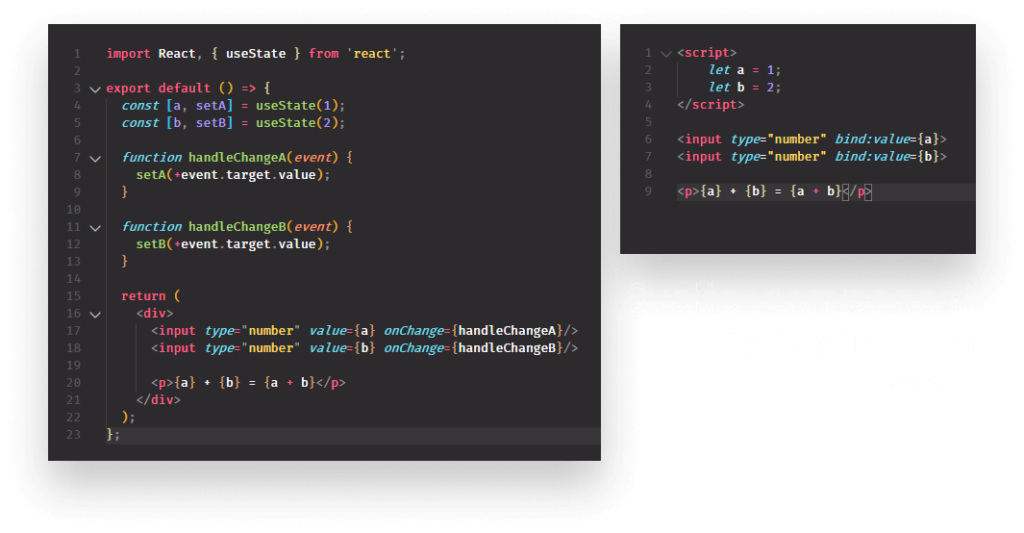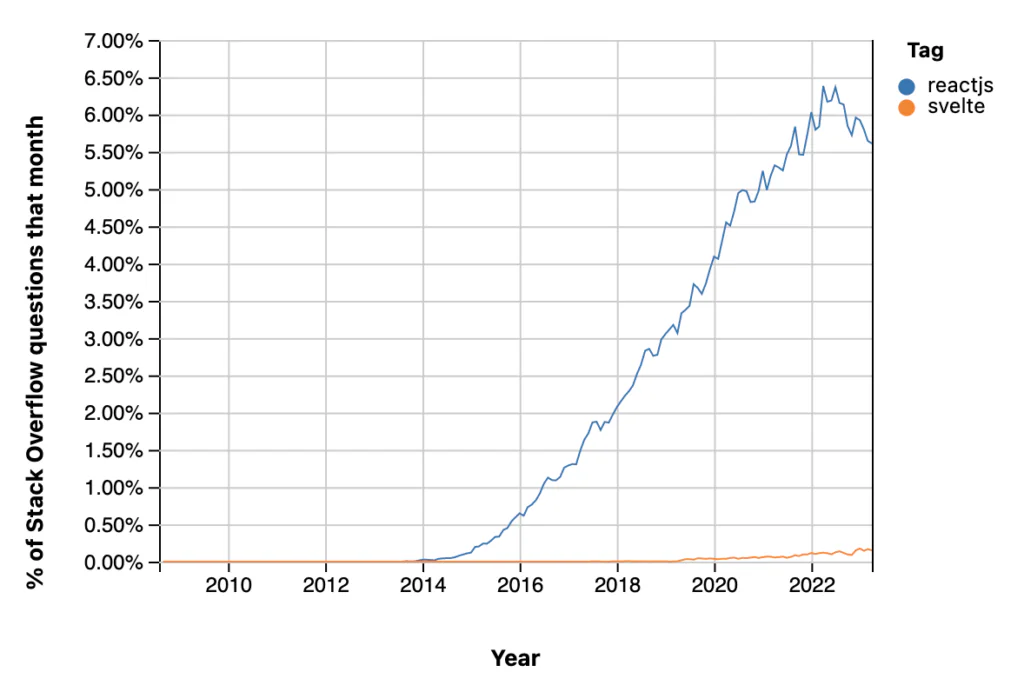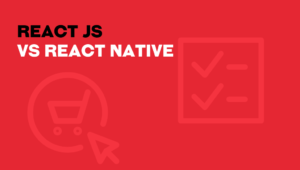
React
React is a well-established JavaScript library created by Facebook in 2011. Some of its biggest perks are a comparatively shallow learning curve, lots of flexibility, and SEO friendliness - thanks to its quick rendering. On top of that, it enables you to cut the development cost.
- 2013Created in
- 42.2KBBundle size
- Great performance
- Supported by large community
- Stable and mature

Svelte
Released in 2016 by Rich Harris. It's a free and open-source front-end component-based framework that works sort of like a compiler. Svelte is fast. It's quite safe to say that Svelte just seems to outperform any other framework, including Angular, Vue, and React.
- 2016Created in
- 1.6 KBBundle size
- Fast development
- Small bundle size
- Exceptional performance
React vs Svelte – Which Is Better For Your Business in 2024?

Intro
What we see lately is an exciting battle between React vs Svelte.
We all know what React.js development is at this point. Megacorps like Amazon, Facebook, Netflix, or Uber all know it, use it, and, my bet is, love it. That said, Svelte is becoming more popular every day, and some believe it’s slowly becoming a rival worthy of challenging React’s dominance.
In this article, we are going to take a look at both React and Svelte in order to find out which one is better for you. To do that, we are going to ponder which software serves best in a given situation by answering the following:
- Which one is more beginner-friendly?
- Which one has the steeper learning curve?
- When to use Svelte and when to use React?
- Which one offers easier access to help and answers?
- Which developers are easier to find and hire?
- What are the differences between react and svelte?
Before we jump into the questions listed above, let us make a quick reminder of what React and Svelte are in the first place.
What is React?
Long story short, React is a well-established JavaScript library created by Facebook in 2011.
The library was made open-source in 2013, quickly topping popularity charts. Widely lauded as the most popular library for building both complex and lightweight single-page apps, as well as rad interactive user interfaces, React has managed to captivate millions of fragile developer hearts all across the globe. And for a good reason, too.
Some of its biggest perks are a comparatively shallow learning curve (not to say it’s easy!), lots of flexibility, and is SEO friendly thanks to its quick rendering. The most important is the one that React enables you to cut the development cost.
Is React good for business?
The quick answer is: yes. React is great for your business.
React components are easier to extend and maintain. These components help empower front-end development teams to increase productivity and save businesses time and money. In addition, React’s reusable nature suits multivariate testing, and helps teams deliver better user experiences which have a positive knock-on effect to goal conversion rates.

With React development services, you are getting a stable, fool-proof platform that is not going to suddenly disappear on you one day. The longer answer is a bit more complicated.
First, as mentioned above, React is here to stay. It’s been around for a decade, and the demand for it continues to grow. Not only is it constantly evolving, but it still is one of the most popular frameworks out there.
React may decrease your worries about changing your framework and re-hiring or re-training specialists every two years, making it a stable choice for the future.
Apart from that, React also allows you to create a product that works on any device and is super SEO-friendly, making it easier for you to drive more organic traffic.
Finally, React specialists are just far easier to find, and the demand for them simply doesn’t seem to be going down whatsoever.
What’s more, React developers appear to be exceptionally satisfied with this framework, which pretty much means it’s easier to find employees who, well, are more likely to enjoy what they are doing.
How does React improve the costs of development?
Oh, this one’s easy. React makes you release the product faster. The work can be done in bundles, allowing you to start smaller by releasing your minimum viable product (MVP) and continue developing from there. If you wonder how to build the MVP, we’ve made a video with a short explanation:

That way, if you plan it right, you can save a lot of time and money by scaling your product and tailoring it to the needs of your users, just like Amazon or Spotify did when releasing their MVPs.
What’s especially important is that React offers a bunch of ready-made components that you can use to build even the most complex apps using simple blocks of code. The components are further divisible into smaller subcomponents. And can also be transferred from one project to another, saving you a lot of time and effort.
With both the components and the subcomponents being responsible for just a tiny part of the app you can build your apps using, mixing, and reusing them over and over again.
If you’re interested in finding out more about the business side of things, check out a comprehensive FAQ that should answer all of your questions in more detail.
Now, let’s move on to Svelte.
What is Svelte?
It’s a free and open-source front-end component-based JavaScript framework that works sort of like a compiler. It came to life in 2016 in response to some of the more traditional frameworks, like React, that do most of their magic in a browser.
Svelte is unlike anything we’ve seen, which obviously has its upsides and downsides… but rest assured, it’s mostly just upsides!
Does Svelte work well for business?
Considering that Svelte has been around for 8 years, it would be rather unfair to say that it is a new platform. React remains the most used front-end framework, but it is important to note that since 2020 Svelte took it over in overall user satisfaction and stayed above React since then. Again, it’s not to say that React is less satisfying to use as it is a mere one per cent difference, but it is a statistic worth keeping in mind when thinking about employee satisfaction.
Svelte is beneficial for businesses primarily because it compiles components into highly efficient imperative code at build time, rather than requiring a virtual DOM at runtime, which can lead to faster, more performant applications.
This efficiency can reduce loading times and improve user experience, which is crucial for customer retention and conversion rates. Additionally, Svelte’s straightforward syntax and component structure make it easier for developers to learn and use, potentially reducing development costs and speeding up project timelines.
Finally, the minimalistic approach of Svelte results in smaller bundle sizes, which not only enhances performance but also reduces the cost and complexity of hosting and scaling web applications.
Svelte also encourage many companies to use it, like Bloomberg and Brave.
Hesitating between React and Svelte?
How does Svelte improve the costs of development?
Did I mention that Svelte was fast? Well, let me say it again. Svelte is fast.
I think it’s quite safe to say that Svelte just seems to outperform any other framework, including Angular, Vue, and React.
One essential distinction between React and Svelte is that Svelte works more like a compiler, while React is more of a classic Javascript library.
Unlike React, which takes advantage of a virtual DOM to break down the app code during runtime, Svelte does most of its work within the compilation step that takes place during build time.
Svelte has demonstrated that you can achieve exceptional performance without the virtual DOM and decided to get rid of it. A bold move that seems to have paid off well performance-wise.
What does it mean for the costs of development? Well, you do get a faster-performing platform that, when used correctly, can bring results quicker.
When hiring a Svelte engineer you’ll be getting a massive cut when it comes to time to market without losing much, if any, quality.
Svelte is truly in its own league when it comes to designing high-quality responsive websites in record time.
The small bundle size of the framework makes the sites more responsive, which results in a super-smooth-running end-product that is sure to satisfy even the most demanding customer.
Alright, let’s get a little bit more technical.
Quick poll
What would you like to use for your next project?
React vs Svelte – A Technical Comparison
| React | Svelte | |
| Creator | Jordan Walke | Rich Harris |
| Year of creation | 2011 | 2016 |
| Maintained by | Community | |
| Performance | Good | Very good |
| Bundle size | 44.5KB (including ReactDOM) | 2.63KB |
| Reactivity | High | Higher |
| Third-party tools | Might be necessary | Unnecessary |
| Pace of development | Fast | Very Fast |
| Community | Rich | Poor |
Performance in Svelte and React
With Svelte you can easily compile and transform any components of your UI into super-clean code that will directly update the DOM.
Unlike the more traditional JS frameworks, like React and Vue, which break down the app code during runtime using a virtual DOM, Svelte does most of its work within the compilation step that takes place during build time.
In short, Svelte is able to cut a lot of corners, making it extremely quick and responsive.
But, realistically, does React really lag that far behind? While React uses a virtual DOM, which introduces an additional layer of abstraction, it has made significant advancements in optimizing rendering and reconciliation processes. React’s vast ecosystem and community support also provide tools and libraries to improve performance further.
Is one more reactive than another?
Compared to React, Svelte can be considered more reactive as it is a serverless-first framework.
There are perks to both, with Svelte being a tiny bit ahead on reactivity.
Svelte is a compiler that, when building an app, simply transforms it into JavaScript code. This means it doesn’t need to add any overhead code to run in the browser when your app updates DOM, making the entire process nice and smooth.
Bundle Size in Svelte vs React
Another cool thing about Svelte is that its bundle size when gzipped is much smaller than that of React, which is critical when it comes to loading time and UI render time.
The GZipped version of Svelte is 2.6KB, while the GZipped version of React is 42.2KB (with ReactDOM included).
Testing
With Svelte you can use the Svelte testing library to perform unit testing. The library itself has far less complex computations and is smaller in size when compared to React, so if you’re looking for cleaner, less bloated, and over-engineered code, Svelte will give you that.
With React you can do a test run of a complete React app in a realistic browser environment (known as “end-to-end” tests), which can greatly reduce time-to-market boosting the overall value you get from it.
Code Maintainability
The code in Svelte is more readable and more maintainable than in React. When talking about Svelte, one has to admit that its structure is just that much smoother which helps quite a bit when you have to define hundreds of components.
Look at this example of React code & Svelte code:

That said, React is incredibly handy when it comes to using different parts of code in separate projects which can greatly improve teamwork and sharing of the code. When hiring new React developers you can count on them catching up with the code very quickly, saving lots of time and effort for the entire team.
Which one’s easier to use?
Svelte did a really good job when it comes to simplifying and clearing up the mess that some frameworks can overwhelm us with thanks to its unique Syntax. The greater part of what we see in Svelte is reminiscent of the classic web development models, using plain JS, HTML, and CSS. Svelte does not use JSX, which is a syntax extension for JavaScript popularized by React. Instead, Svelte has its own templating syntax, which is more declarative and closely resembles plain HTML.
React on the other hand requires more advanced programming knowledge like JSX and CSS-in-JS to create the simplest of interfaces.
Community Support
I know it’s looking extremely promising but do keep in mind that Svelte remains more of a, err,... hipster platform.

With React being undoubtedly one of the most popular web framework among professional developers as of 2023, Svelte pales in comparison, taking one but the last place in the tally.
In general, Svelte is a far less common platform which means that Svelte developers are much tougher to find. What might be the biggest deal, however, is that Svelte is not supported by any major company, making it a less stable option than React, which is a Facebook library.
There’s a lot to be said about Svelte being a small fish, not-so-popular, and perhaps not as sure a bet as React, but, and a big but at that, all of this doesn’t change the fact that Svelte continues to inspire and satisfy developers after seven long years.
And still, more developers are learning to use React.js and so React has a large developers pool.

…the Svelte framework community is super happy about using it.

When to use React and when to use Svelte?
ReactJS remains a clear go-to library. With a well-established community and the support of a major company (Facebook!), it is quite clear that it is a very solid choice. React is used by many biggest players on the market, like Facebook, Instagram, etc. React has a large ecosystem, so when you create React app it has your back, providing you with the necessary tools, libraries and other devs to answer your questions in no time.
Svelte provides a shallower learning curve when compared to React. It also has a cleaner code and perhaps is more intuitive. When building simple websites and apps, Svelte, which offers improved load and render times, seems to be the way to go.
Also, styling on Svelte is a breeze and the apps you create run super smoothly. On the one hand, Svelte is better for beginners as it is easier to learn and understand, while on the other hand, React is a much more popular, well-established platform, with a Reddit community of 365k and almost unlimited resources. Svelte’s Reddit community stands at a comparatively low 29k, but its members are incredibly active and always eager to help. From the beginning of 2023, this community grew by 18k, while React’s community by 20k, so the community growth is comparable.
Experienced React developers are also much easier to find as there are just so many of them.
Best Use Cases for React:
Large-Scale Applications: React’s component-based architecture and virtual DOM make it well-suited for building large-scale applications with complex UI requirements. It provides a scalable and maintainable structure for managing and updating UI components efficiently.
RELATED CASE STUDY
Check how we’ve built a web app for the leading insurance provider in the UK using React
READ CASE STUDY
Interactive User Interfaces: React’s reactivity and efficient rendering make it an excellent choice for building interactive user interfaces with real-time updates, such as social media platforms, collaborative tools, or live chat applications.
Single-Page Applications (SPAs): React’s ability to handle state management, routing, and dynamic component loading makes it ideal for building SPAs where fast and seamless navigation between views is crucial.
Cross-Platform Development: React’s versatility allows for developing cross-platform applications using frameworks like React Native for mobile app development or React Native for Web for web and desktop applications.
Enterprise Applications: React’s extensive ecosystem, mature libraries, and integration capabilities make it a popular choice for building enterprise-grade applications. It can easily integrate with existing backend systems and enterprise tools, making it suitable for corporate environments.
Best Use Cases for Svelte:
Lightweight and Fast Applications: Svelte’s compilation-based approach results in highly optimized and minimalistic code, leading to smaller bundle sizes and faster load times. It is well-suited for building lightweight applications that prioritize speed and efficiency.
Single-Page Applications (SPAs): Svelte’s efficiency and reactivity make it a strong contender for building SPAs that require fast rendering and smooth transitions between views.
Progressive Web Applications (PWAs): Svelte’s small bundle size and efficient code execution make it ideal for building PWAs, allowing users to have a native-like experience on web platforms.
Resource-Constrained Environments: Svelte’s lightweight nature and efficient code generation make it suitable for resource-constrained environments, such as IoT devices or low-bandwidth networks, where optimizing resource usage is critical.
It’s important to note that these use cases are not exclusive, and both React and Svelte can be used effectively in various scenarios. The choice between React and Svelte should be based on the specific project requirements, development team expertise, and desired performance characteristics.
React vs Svelte – The Verdict
Some believe that Svelte is the future, but considering the gap between it and the top JavaScript libraries like React, it has to be said that is a very bold claim.
Svelte is truly a one-of-a-kind platform that continues to grow in popularity every day. Many experienced developers find it to be absolutely game-changing and decide to migrate to it after years of using different, better-established platforms, like React, Angular, or jQuery.
For an experienced JS developer, Svelte could be a great place to experiment, find inspiration, and perhaps learn something new.
On the other hand, React is incredibly flexible and can be used to develop apps or other interfaces on many different platforms. Despite the easier learning curve of Svelte, beginners should probably take React’s slogan “Learn Once, Write Anywhere.” to their hearts and start there.
Both React and Svelte are excellent for building web applications. React is a safer bet for anyone looking for a well-established framework with a rich community behind it. Svelte is a wonderful option for those with experience and wiggle room who are looking for a platform that could help them optimize their work even further.
Further readings
There’s still some knowledge you may want to dig deeper into.
Check what you can build with React.js
FAQ
What does the job market for React and Svelte developers look like?
If it’s about the job market, React developers are both more popular and more wanted across the globe. This is primarily due to React’s longer presence and wider adoption among various industries. The job market for React developers provides a wide range of opportunities, with almost 10,000 open React vacancies on Indeed, 17,400 on ZipRecruiter, and over 62,000 on LinkedIn in the US alone.
At the same time, Svelte’s growing satisfaction among its users presents a promising perspective for those specializing in or transitioning to this framework. The demand for Svelte developers is expected to grow as it gains more recognition, especially among startups looking for innovative front-end solutions.
What are the long-term maintenance considerations when choosing between React and Svelte for a project?
Scalability: React’s component-based architecture encourages and promotes reusability of the components across the same and other projects. It makes it well-suited for large-scale applications, but also for those that are about to grow (or that are about to have other platforms built all around it). React was designed to efficiently update and render components, and that’s crucial for high-performance applications.
On the other hand, Svelte compiles highly optimized vanilla JavaScript, and as a result, it leads to smaller bundle sizes and faster load times, which can also benefit scalability, especially for projects concerned with initial load performance and smooth runtime efficiency.
Maintenance Costs: React’s extensive ecosystem and large community mean a wealth of resources, tools, and pre-built components. This can potentially lower maintenance costs by enabling to reuse of existing solutions. Additionally, devs have access to quick support from the community, so they can fix bugs and get the questions answered much quicker. However, the need to stay up-to-date with the latest React versions and associated libraries might increase maintenance efforts.
Svelte aims to simplify development with a less complex API and fewer external dependencies, which can lead to lower maintenance costs. However, the smaller community might result in higher costs (and longer development time) when custom solutions are needed.
Access to Developers: React, being one of the most popular front-end frameworks, has a large pool of developers. This accessibility makes it easier to find experienced developers for project development and maintenance.
Svelte’s growing popularity is encouraging, but its developer pool is currently smaller than React’s, which may affect hiring and the potential need for developer training.
Future-Proof Solution: React, which is backed by Facebook (now Meta) and its massive adoption across various industries suggest its staying power in the industry, making it a relatively safe choice for future-proofing a project.
Svelte, while newer, has been gaining traction for its innovative approach to web development, offering a compelling alternative that prioritizes performance and developer experience. Its growing popularity indicates a promising future, but its long-term position in the industry is less certain than React’s.
Sources:



comments
CodeMonkey
Posted on
Using the number of StackOverflow questions to measure community support is a bit unfair as Svelte is just HTML/CSS/JS.
It’s very rare that you’ll have an issue with Svelte itself or the “Svelte-way” to do things as it is somewhat inexistent compared to React. People will make questions about CSS, HTML or JS.
Learning React (and by extension, JSX/TSX) is essentially learning a new language and therefore React is filled with “React-way” of doing things.
I think it’s a good article but I’m gonna leave a (very opiniated) comment here:
If you’re a new developer, I would just go with Svelte rather than React.
React is slowly dying despite what people are telling you. Unless Facebook changes its vision, React will become the next jQuery: A heavy, once-useful and revolutionary piece of legacy garbage. Or even worse: the next Angular.
Companies are hiring React developers because they need to maintain their old codebases but more and more significant companies are starting new projects on Svelte and Vue because you spend more time actually building a product than writing useless and pointless boilerplate code.